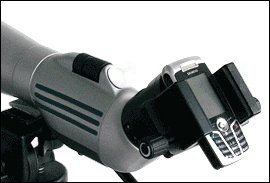2006 Hunting Optics Roundup
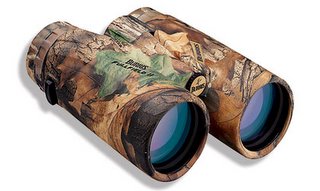
Interested in hunting or stealthy animal observation? This story rounds up new products for 2006. Camo is a cool look in any case.

Mr. Gresham's company designs customer-incentive and loyalty programs for banks. Like it or not, free gifts are a big part of those programs.
"We're not claiming this is more important than convenience and customer service, but it's the minimum you have to do to even compete," he said. "If you don't offer those things, you don't have a chance of retaining customers."
Free gifts even beat out cash in attracting customers, he said.
"What the consumers tell us is that cash was vaporware," Mr. Gresham said. "There's no association back to the bank with that cash.
"We use the gift as the tipping point to call them to action. There's a greed factor to every person, and getting something for nothing creates a call to action. There's a trophy value associated with a physical item that's given."
Mr. Gresham's company doesn't deal in cheesy items. We're talking Pyrex Portables, Bushnell binoculars and Mikasa crystal picture frames.
You can see enough stars with your naked eye or a good pair of binoculars, says Sandra Ferguson, speaker at the Brown Bag Lunch on January 18.
“Get binoculars,” she recommends. “They are far better than a telescope. Telescopes have a smaller field of vision. If you don’t recognize where you are looking, it is hard to find things. Telescopes can be very expensive.”
She uses a 7 x 50 binoculars which is a standard lens and makes objects appear seven times closer, similar to a birdwatcher’s pair. Sandra is a member of the Royal Astronomical Society, Belleville chapter, and has been studying the stars and teaching astronomy in schools for 30 years.
She had a couple of tips for novice star gazers. First get a star chart that shows the constellations for that time of year. Next get a piece of red cellophane to put over your flashlight so you can read the star chart while outside at night. “The red doesn’t bother your eyes,” she says.
...

Great for anyone, any scope.January 27 marks the night that Saturn arrives at opposition to the sun; rising in the east as the sun sets, peaking high in the south at midnight and setting in the west at sunrise.
Without question Saturn's famous rings make it the telescopic showpiece of the night sky. In small telescopes, they always surprise observers, both novice and veteran alike, with their striking beauty. Any telescope magnifying more than 30-power will show them quite well.
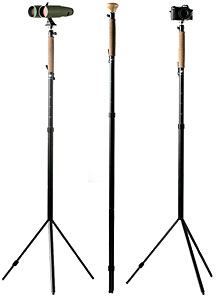
Connors said he also attended conventions and joined the Kanawha Valley Astronomical Society. He wanted his own telescope, but when he learned it would cost about $4,000 to build one, he decided to use his combination of skills to construct his own.
He bought a lens from the society and built his first telescope, an 8-inch, F-6 refractor in a graphite tube on an equatorial mount.
He then built two more telescopes and turned them into a set of 350-pound binoculars with two 6-inch, F-15 refractors.
...
He loved using the binoculars and sharing his love for stargazing with others. However, it took an hour and 20 minutes to set them up. He figured the answer to eliminating the cumbersome task would be to build his own observatory.
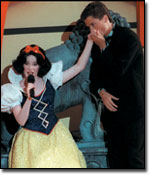
The Minuteman Project, co-founded by Gilchrist, uses volunteer civilians to patrol the U.S.-Mexico border for illegal immigrants. Gilchrist ran unsuccessfully for the 48th congressional district last year and has suggested he may challenge Gov. Arnold Schwarzenegger for re-election.
The organization proposed a float bearing dancers who would perform a choreographed act with binoculars and folding chairs to imitate border patrollers and another group of actors in Revolutionary War costumes, Gilchrist said Monday during a telephone interview. About 400 civilian volunteers would follow the float on foot, he said.

"...I'm referring to this guy in Woodlands who was questioned by the police recently because he paraded naked before his window and an offended woman living in the opposite block called the cops.True, he was more than just naked. According to news reports, he was, ah, sexually 'relieving' himself in full public view.
What's wrong with the guy? Why couldn't he have done that in the toilet or in front of the computer like the rest of the male population?
Of course, I don't know what's wrong with the neighbour either. See, in the old days when policemen wore shorts, one would intentionally look into your neighbours' window hoping to catch a glimpse of some action, with the lights off and a pair of binoculars.
In those days, nobody complained about seeing naked bodies. In fact, it was pretty much a bonus.
Of course, I never did anything like that. I was never rich enough to own a pair of binoculars powerful enough."
"Visiting nine islands in seven days, my fellow Polaris passengers and I got the point that this is a Mother Nature hotspot. With all the animals we viewed, I was surprised I found the birds among the most appealing. Being able to walk up to hundreds of them at close range made bird watching far more interesting than that thing with binoculars."If only the scenery were always so cooperative.
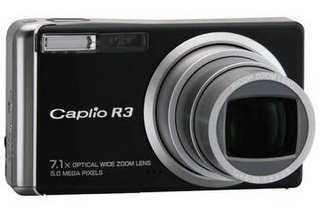 Stuff Magazine raises an interesting point: small digital cameras can function as makeshift binoculars (or, more properly, a monocular). The obvious drawback is that extended viewing will suck your batteries dry and result in missed photos, but as the technology progresses it should become a viable option.
Stuff Magazine raises an interesting point: small digital cameras can function as makeshift binoculars (or, more properly, a monocular). The obvious drawback is that extended viewing will suck your batteries dry and result in missed photos, but as the technology progresses it should become a viable option.

Basic Concept: In the past 150 years, the Willapa Entrance has changed dramatically. Charts and topographic maps of 150 years ago show a long spit arching down to the southeast from Cape Shoalwater into the entrance, and the main channel near present day Leadbetter Point. Successive charts map the shift of the main channel northward over the next 150 years. During those decades, Cape Shoalwater disappeared into the surf and Leadbetter Point built up out of the surf and extended northward. This situation is not unique to this or any other coastline, and serves as a severe reminder of the fragility of coastal lands built of sand. Similar stories could be told for Grays Harbor and Columbia Entrances; see Komar for several such tales on the Oregon Coast.
...

"The concept is simple. Any camcorder can be positioned above the Lightsmith platform using the flexible camera arm. Our patent pending reversible camera mount lets the user capture video images right side up and from any angle desired. Powered by the camcorder's AC power supply, images of amazing resolution can be displayed on a TV, an LCD projector, or a computer. Unlike other visual presenters, hours of presentations can be easily captured to tape or DVD for later editing or review. And by taking advantage of a camcorder’s fold-out LCD screen to see what is being displayed, a Lightsmith can always be operated facing the students. Can you tell that a teacher designed this?"It received a rave review from thejournal.com. After outlining many typical uses and new discoveries, the article concludes:
"I've always loved camcorders, but I'm still amazed at how this familiar tool has been transformed in our classrooms. Our district is now using more than 30 Lightsmith Video Platforms with either Digital 8 or DV camcorders, and new ideas just keep coming. And with a Lightsmith Video Platform at only $200, and digital camcorders running about $350, it's the best presentation technology bargain we've seen."

When the idea of reintroducing elk into the Eastern Kentucky mountains was little more than a wistful dream floating around the Department of Fish and Wildlife Resources' Game Farm headquarters, one of the potential byproducts foreseen was a boost in tourism.
After all, wildlife watching is big business, and elk are among the rock stars of the animal world.
According to a 2001 survey conducted by the U.S. Fish and Wildlife Service, 1.36 million Kentuckians spend about $6 million annually watching, feeding and photographing various critters. Nationwide the numbers are a staggering 66.1 million people spending $38.4 billion.
With a little help from the Rocky Mountain Elk Foundation, the project literally hit the ground running in 1997 when seven elk were released. During the next five years hundreds more were transplanted from various Western states.
Today Kentucky boasts the largest free-ranging herd east of the Mississippi River, with about 5,500 elk. Hunting opportunities are expanding -- 200 tags will be offered through a quota draw this year -- and the big animals are free to roam across a 16-county restoration zone. Elk-related complaints have been few.
The animals' impact on tourism has been difficult to gauge, according to Parks Department spokesman Doug Bennett, but elk watchers are standing in line to get on the bus.
"Our trips nearly always fill up," said Trinity Shepherd, the naturalist at Jenny Wiley State Resort Park near Prestonsburg. "We could take twice as many as we have room for. Probably more than that."
Jenny Wiley has six elk tours scheduled now through early March. If you want to go, Shepherd suggests making reservations early.
"Definitely," he said. "The sooner the better."
The park tours have access to a slice of elk range most people don't get to see. The van trips go to the Starfire area in Perry County, which is part of an active mining operation that is otherwise off-limits to the public aside from a handful of limited-entry permits for the fall elk hunt.
"The location we go to is the spot where elk were first reintroduced," Jenny Wiley park manager Scott Ringham said. "Nearly every trip we have is sold out."
...

The job of participants is literally to hide, behind cedars and bayberry, within river birch. The job of the ranger is to imitate the calls of wild ducks, using different hand-carved calls, which are among hunters' most prized tools. These slender instruments, chilled by onshore winds, can sound high and panicky at first, then deepen. Each whittled call creates a different sound. One signals "food here!," another, which sportsmen call "the hook," induces fowl to hook back in for a second look.
Mr. Harley's tools are working decoys and calls. They are not the artistic version, made for show, and frequently sold for thousands of dollars.
"Decoys have to persuade," the ranger instructs. "Those ducks are smart — it's life and death." Duck shapes of plastic or foam are precisely weighted so as to bob convincingly on the water. "Every time I put out a spread, it's fresh (different)," he said. Fellow fowl-watchers, tucked behind shrubs and downed trees, "make use of natural cover — nothing man-made. I call them 'hides', not blinds."
Piedad Bernikow, an attorney whose wildlife photography has been published "all over the world," took her first duck-hike with Ranger Harley early this month.
Ms. Bernikow is a regular preserve visitor because she finds nature "gorgeous — and this place 'a little bit of heaven.'" What she most enjoyed about her hike, "apart from when the ranger fell in the water," was that "he led us on 'a trail not taken.'"

"The graphics are excellent, with explosive sound. It might seem silly, but just watching the tank shells explode — the way they kick up the desert sand and shred the other side’s machines — was fun to see. When the player looks through his character’s binoculars, the lenses are scuffed and scratched from previous hard use."

"People are surprised," says Pinizzotto. "They ask, 'What night can I see a satellite?' No, it's 'How many satellites can I see on any given night?' "
Pinizzotto logged 40 one summer evening from a lawn chair in Maine. The dean of science and engineering at Merrimack College here, he's also an avid satellite observer, one in a subset of skygazers who like their astronomy with an earthbound twist.
Part bird-watchers, part train-spotters, these people know their star charts. But they are as likely to rhapsodize about a sighting of the International Space Station, XM Radio's geostationary duo (dubbed "Rock" and "Roll"), or an iridium flare (a flash of reflected sunlight from a communications satellite) as they are to gush about a glimpse of Saturn's rings.
This game is as old as Sputnik, and it can often be played from any dark spot with the unaided eye. (Warning: It's hard to stop.) But participants' skills have improved along with sky-tracking software and good, inexpensive telescopes and mounts.
"The astronomers used the Exoplanet Tracker on the special 0.9-meter Coude feed system within the National Science Foundation's 2.1-meter telescope at Kitt Peak National Observatory near Tucson, Ariz.
The new planet is the most distant ever found using the Doppler technique with a telescope mirror less than 1 meter in size. There are hundreds of such telescopes worldwide, compared with just a handful of the larger telescopes more commonly used in planet finding, researchers said."
I'm impressed by the feat, but my definition of small means scopes that can be carried by a single individual, and generally with one hand.
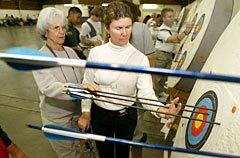
Janice, like the rest of the field, shoots 120 arrows — 40 rounds of three, or "ends" in archery parlance — over 9 hours in two days during the weekend. A perfect score is 1,200, meaning 120 10s. The best in this tournament is 1,140.
Janice scores 435.
"Last year I shot 478. I'm disappointed because I wanted to beat last year's score. And, since I have nobody else to compete against, I compete against myself."
Asked if she beat anybody, she says, "I may have beaten one of the 6-year-olds. I doubt that I beat many people, but I don't care."
Her mother adds, "She does her personal best, and that's where it is right now."
Walth is on a two-fold mission: improve her score to the point she's challenging the lower level of "sighted" archers; and, above all, promote the sport among the blind.
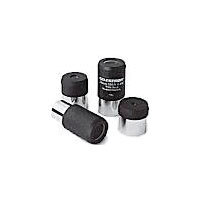




"...It's about the size of a pair of binoculars, but it only has one viewing lens. On the side is a digital readout, and inside, it packs an impressive amount of technology, including GPS and the ability to calculate the angle at which you're pointing it at the sky.You see, if you point the SkyScout skyward -- indoors or out -- it will tell you precisely what's above you with the click of a button. It can also guide you to the night's celestial highlights with a series of arrows inside the lenses. For example, if you want to know where Mars is in the sky, just hold it up, and red arrows that blink as you move the SkyScout across the horizon will find it.
This may even fall under the somewhat rare "e" category for gadgets, as in educational. It's expected to ship in early spring for about $399."


"Shortly after the birders left, the owl stretched its massive five-foot wings and took flight. It flapped three times then rode the ground effect, gliding for what seemed an impossibly long time just above the earth before landing.
Twenty seconds later, it flew again. This time it landed atop a runway direction sign. And a crow, looking like a sparrow next to the snowy owl, began to harass the larger bird. It flew at it, landed and postured close to the owl and then dive bombed.
The owl didn't seem bothered. Nor did it appear at all ruffled when a Champion Air 727 taxied within 50 feet of the bird.
It sat there, magnificent, as if it were Ruler of the Universe."
"They go in cycles," Gleason says. "Every few years big numbers of them start moving farther south. Some of the old literature says that as the lemming population increases up north, so do the snowy owls. Then as the lemming population crashes, they move south."




"In a county where volunteer fire departments occasionally raffle firearms to raise funds, recent acquisitions such as the HazMat truck would likely have been impossible without outside funding. The truck comes complete with a mobile weather station, night vision binoculars that cost $3,878.98 each and a camera that relays back everything a firefighter sees on scene."
